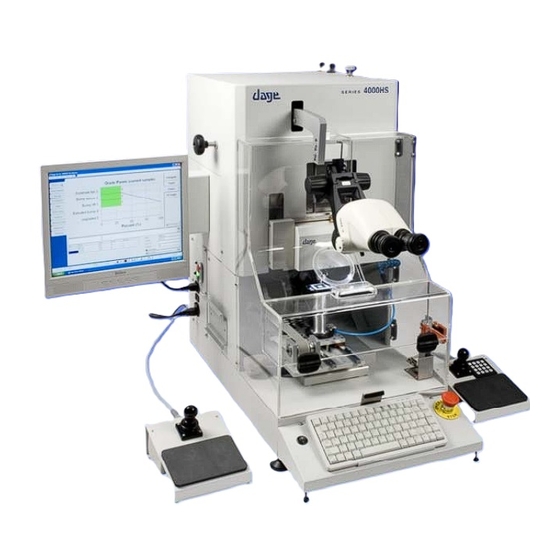
Table of Contents
Advertisement
Advertisement
Table of Contents

Summarization of Contents
IMPORTANT INFORMATION FOR OUR CUSTOMERS
DAGE SUPPORT SOLUTIONS
Outlines Dage's commitment to customer service and support worldwide.
TYPES OF MACHINE 4000, 4000HS AND 4000HS-Z
Machine Models Overview
Details the capabilities and differences between the 4000, 4000HS, and 4000HS-Z machines.
SAFETY INFORMATION
SYMBOLS AND LABELS
Explains warning symbols, signal words (DANGER, WARNING, CAUTION), and associated hazards.
TIPPING AND CRUSHING HAZARDS
Warns about the machine's high center of gravity and weight, advising caution during handling.
LOCATING THE MACHINE
UNPACKING THE MACHINE AND THE WORK STATION
Provides step-by-step instructions for safely unpacking the machine and setting up the work area.
Workbench Requirements
Specifies criteria for a suitable workbench, including sturdiness, rigidity, and height.
Chair Requirements
Details ergonomic requirements for the operator's chair, including height and backrest adjustment.
ELECTRICAL CONNECTIONS
Critical safety instructions for earthing, fused power sources, and correct voltage selection.
PNEUMATIC SERVICES
Outlines requirements for compressed air and vacuum supply, including regulator settings.
FITTING MACHINE MODULES
Instructions for installing optional modules like joysticks, keypads, and microscope components.
SETTING UP THE WORK STATION
ERGONOMICS AND OPERATOR COMFORT
Recommends posture and positioning for optimal operator comfort and reduced muscular tension.
SETTING THE MACHINE FOR AN OPERATOR
Guides on adjusting the chair, joysticks, and microscope for individual operator needs.
UNDERSTANDING THE MACHINE
TURNING ON
Step-by-step guide for powering up the machine and initializing its axes.
TURNING OFF
Procedures for safely shutting down the machine and its associated software.
EMERGENCY STOP BUTTON
Details the function, location, and procedure for using the emergency stop button.
BASIC OPERATOR CONTROLS
Overview of the machine's primary controls including on-screen, keypad, and footswitch operations.
UNDERSTANDING CARTRIDGES
Information on handling, storing, and the general layout of machine cartridges.
PREPARING FOR A TEST
FITTING A CARTRIDGE
Instructions for correctly installing a cartridge into the machine, including safety precautions.
FITTING AND USING WORK HOLDERS
Guidance on installing and using various work holders for different test configurations.
DOING A TEST
NEW SAMPLE
Explains how to set up a new sample for testing and configure test parameters.
COLD BUMP PULL TESTING
Detailed procedure for performing cold bump pull tests, including tool quality and alignment.
BUMP PULL TEST MODES
Describes different test modes like Auto, Delayed, and None for bump pull operations.
BUMP PULL TEST FAILURE MODES
Illustrates and explains common failure modes encountered during bump pull testing.
TEST RESULTS
How to view, interpret, and manage test results, including grading and statistics.
CALIBRATION
COLD BUMP PULL CARTRIDGE CALIBRATION
Steps for calibrating the cold bump pull cartridge using specific weights and hooks.
SHEAR CARTRIDGE CALIBRATION
Procedures for calibrating shear cartridges, including specific jigs and weight requirements.
GETTING DATA FROM ANOTHER MACHINE
SELECTING A REMOTE MACHINE
Instructions for connecting to and retrieving data from other compatible Dage machines.
QUESTION AND ANSWERS
DATA STORAGE
Explains the concept of samples and how test data is stored and managed.
CALIBRATION WORKFLOW
Details the process and principles behind how the machine's calibration functions.
JOGGING PROBLEMS
Troubleshooting guide for issues related to cartridge or table movement during jogging.

Need help?
Do you have a question about the 4000HS and is the answer not in the manual?
Questions and answers